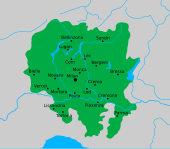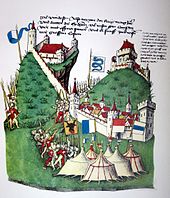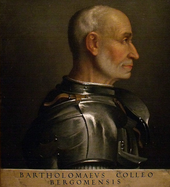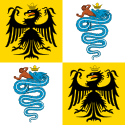Duchy of Milan
Duchy of Milan | |||||||||||||||||||
|---|---|---|---|---|---|---|---|---|---|---|---|---|---|---|---|---|---|---|---|
| 1395–1447 1450–1796 | |||||||||||||||||||
Duke | | ||||||||||||||||||
• 1395–1402 | Gian Galeazzo Visconti (first) | ||||||||||||||||||
• 1792–1796 | Francis II (last) | ||||||||||||||||||
| Historical era | French occupation | 1499–1512, 1515–1522 and 1524–1525 | |||||||||||||||||
• Protectorate of the Swiss Confederacy | 1512–1515 | ||||||||||||||||||
• Habsburg rule | 1535–1796 | ||||||||||||||||||
• Spanish rule | 1556–1707 | ||||||||||||||||||
• Austrian rule | 1707–1796 | ||||||||||||||||||
• Annexation to the Transpadane Republic | 15 November 1796 | ||||||||||||||||||
Population | |||||||||||||||||||
• Estimate | 750,000 in the 17th century | ||||||||||||||||||
| Currency | Milanese scudo, lira and soldo | ||||||||||||||||||
| |||||||||||||||||||
| Today part of | Italy Switzerland | ||||||||||||||||||
The Duchy of Milan (Italian: Ducato di Milano; Lombard: Ducaa de Milan) was a state in Northern Italy, created in 1395 by Gian Galeazzo Visconti, then the lord of Milan, and a member of the important Visconti family, which had been ruling the city since 1277.[1][2]
At that time, it included twenty-six towns and the wide rural area of the middle
Under the House of Sforza, Milan experienced a period of great prosperity with the introduction of the silk industry, becoming one of the wealthiest states during the Renaissance.[3]
From the late 15th century, the Duchy of Milan was contested between the forces of the
After the defeat of Napoleon, the
History
Background

The fate of the city of Milan was intertwined since the 13th century with that of the Visconti family, who resumed the policy of territorial expansionism inherited from the city's municipality. One of the first Visconti exponents to lead the Lombard city was Ottone Visconti, elected archbishop in 1262 and who defeated the Della Torre family in the Battle of Desio in 1277.[6]
In the first half of the following century, his nephews and great-grandsons who came to govern Milan: Matteo I, Galeazzo I, Azzone and the Archbishop Giovanni, expanding the area of Visconti influence over the surrounding regions. An equal policy of enlargement and consolidation was pursued in the second half of the century by their successors: Matteo II, Bernabò and Gian Galeazzo. After a period marked by tensions between the various members of the powerful family, Gian Galeazzo Visconti, nephew of Bernabò, came to power with a coup in 1385 and gradually unified the vast family domains scattered across Northern Italy.[7][8]
It is said that the territories subject to his dominion earned Gian Galeazzo in one year, in addition to the ordinary income of 1,200,000
Visconti's rule (1395–1447)

The duchy was officially established on 11 May 1395, when
The duchy, as defined in the diploma of 1395, included the territory surrounding Milan, between the Adda and Ticino rivers,
The brothers Luchino and Giovanni Visconti added Bellinzona (present-day Switzerland in 1342, Parma (Emilia) in 1346 and several territories in southwestern Piedmont in 1347: Tortona, Alessandria, Asti, and Mondovì. Bernabò conquered Reggio Emilia in 1371 and Riva del Garda in 1380, and Gian Galeazzo greatly expanded Milan's dominions, first eastwards, with the conquest of the Venetian cities of Verona (1387), Vicenza (1387), Feltre (1388), Belluno (1388) and Padua (briefly, from 1388 to 1390), and later southwards, conquering Lucca, Pisa and Siena in Tuscany in 1399, Perugia in Umbria in 1400, Bologna in Emilia in 1402, and Assisi in Umbria also in 1402.[16]
Ambrosian Republic (1447–1450)

When the last Visconti duke, Filippo Maria, died in 1447 without a male heir, the Milanese declared the so-called Golden Ambrosian Republic, which soon faced revolts and attacks from its neighbors.[17] In 1450 mercenary captain Francesco Sforza, having previously married Filippo Maria Visconti's illegitimate daughter Bianca Maria, conquered the city and restored the duchy, founding the House of Sforza.[18]
First Sforza's rule (1450–1499)
The
The political balance achieved with the Peace of Lodi lasted until the death of Lorenzo de' Medici, ruler of the Florentine Republic, and the incursion of King Charles VIII of France into Italy in 1494, except for some Swiss incursions which resulted in the Peace of Lucerne.[20]

Relations between Ludovico and Ferdinand II of Aragon therefore deteriorated: Gian Galeazzo had in fact married a niece of the King of Naples, who took the side of the legitimate heir. Ludovico il Moro responded by encouraging King Charles VIII of France to reclaim the Kingdom of Naples, as until 1442 the Neapolitan throne had belonged to Charles ancestors, the Capetian House of Anjou. In 1494 Charles VIII conquered Naples, upsetting the balance between the various Italian states and starting the Italian Wars.[22][23]
First French rule (1499–1512)
In 1495 Charles VIII was expelled from the Peninsula by a League composed of many Italian states, the Holy Roman Empire, the Spanish Empire and the Kingdom of England, but only three years later, in 1498, the Duke of Orléans, who had become King of France with the name of Louis XII, assert his claims on the Duchy of Milan: one of his ancestors, Louis of Orleans, had in fact married Valentina Visconti, daughter of Duke Gian Galeazzo, in 1389, whose marriage contract established that, in the event of the extinction of the Visconti dynasty, the title of Duke of Milan went to Valentina's descendants. Louis XII, claiming to be the legitimate heir of the Viscontis, invaded the Milanese state in 1499, driving out Ludovico il Moro. The former Sforza ruler tried in vain to counter the transalpine troops, even asking the Emperor for help, but only managed to briefly recapture the capital and a few other lands. Defeated and taken prisoner in Novara in 1500, he was deported to France, to the Castle of Loches, where he died on 27 May 1508.[24][25]
Second Sforza's rule (1512–1515)
Louis XII remained Duke of Milan until 1512, when the Swiss army expelled the French from Lombardy and placed Maximilian Sforza, son of Ludovico il Moro, on the Milanese throne. Between 1512 and 1515 the Swiss cantons de facto controlled the duchy.[26]
Second French rule (1515–1521)
Under the reign of
Third and last Sforza's rule (1521–1535)

After the decisive French defeat in the
Francesco II Sforza died without heirs in 1535, opening a new question for the succession to the throne. In this period, to be precise in 1532, Francesco II Sforza requested and obtained from Pope Clement VII the elevation of
Spanish Habsburg rule (1556–1707)
Emperor Charles V held the duchy from 1535, eventually granting it to his son King
The Duchy of Milan remained under the rule of the Spanish Habsburgs until the War of the Spanish Succession (1701–1714), when the Austrians invaded it (1701) and obtained it with the Convention of Milan in 1707, formalised at the Peace of Utrecht in 1713.
Austrian Habsburg rule (1714–1796)
The duchy remained in Austrian hands until it was overrun by the French army of
Military
Under the Spanish viceroys from 1535, Milan became one of the contributors to the Spanish king's army. At the time Lombardy had the most developed manufacturing and commercial economy anywhere in the world, making it a valuable tool for the Spanish military: an armory of paramount strategic importance.[34] In addition to resources, Milan also provided soldiers. During the 1635–1659 Franco-Spanish War, Milan sent and paid for on average 4,000 soldiers per year to the Spanish crown, with many of these men serving in the Low Countries against the Dutch States Army.[35]
Legacy
After the defeat of Napoleon, based on the decisions of the Congress of Vienna on 9 June 1815, the Duchy of Milan was not restored. The duchy instead became part of the Kingdom of Lombardy–Venetia, a constituent of the Austrian Empire and with the Emperor of Austria as its king. This kingdom ceased to exist when the remaining portion of it was annexed to the Kingdom of Italy in 1866.
Historical coat of arms
- Coat of arms
-
1395–1535
(Under the Visconti and Sforza dynasties) -
1580–1700
(Under Spanish Habsburgs) -
1707–1796
(Under Austrian Habsburgs)
Rulers
See also
References
- ^ Black (2009), pp. 68–72
- ^ a b "::: Storia di Milano ::: dal 1201 al 1225". www.storiadimilano.it. Retrieved 1 July 2020.
- ^ "Milan – History". Encyclopedia Britannica. Retrieved 17 December 2020.
- ^ "Storia di Milano ::: dal 1701 al 1725". www.storiadimilano.it. Retrieved 1 July 2020.
- ^ "Storia di Milano ::: dal 1776 al 1800". www.storiadimilano.it. Retrieved 1 July 2020.
- ^ "I Visconti, Signori di Milano". www.storico.org. Retrieved 25 April 2024.
- ^ "I Visconti, storia e segreti dei signori di Milano". Connessioni Culturali (in Italian). Retrieved 25 April 2024.
- ^ "Ducato di Milano: origini e storia dei Visconti e degli Sforza | Studenti.it". www.studenti.it (in Italian). Retrieved 25 April 2024.
- ^ "1300: dalla signoria milanese dei Visconti agli Sforza". Skuola.net - Portale per Studenti: Materiali, Appunti e Notizie (in Italian). Retrieved 25 April 2024.
- ^ "Gian Galeazzo Visconti e la nascita del Ducato di Milano". Navigli Reloading (in Italian). Retrieved 25 April 2024.
- ^ "GIAN GALEAZZO Visconti, duca di Milano - Treccani". Treccani (in Italian). Retrieved 25 April 2024.
- ^ Black (2009), p. 69
- ^ Bueno de Mesquita (1941), pp. 174–301
- ^ Knight, Charles (1855). The English cyclopedia: geography. London.
{{cite book}}: CS1 maint: location missing publisher (link) - ^ "VISCONTI". Archived from the original on 9 April 2022. Retrieved 3 July 2020.
- ^ Chamberlin (1965), p. 196.
- ^ Aeneas Sylvius Piccolomini (Pope Pius II), The Commentaries of Pius II (Northampton, Massachusetts, 1936–37) pp. 46, 52.
- ^ Cecilia M. Ady, A History of Milan under the Sforza, ed. Edward Armstrong (London, 1907) pp. 56–60.
- ^ "Francésco I Sforza duca di Milano - Treccani". Treccani (in Italian). Retrieved 25 April 2024.
- ^ "Francesco Sforza | Renaissance Ruler of Milan | Britannica". www.britannica.com. 8 April 2024. Retrieved 25 April 2024.
- ^ "Galeazzo Marìa Sforza duca di Milano - Treccani". Treccani (in Italian). Retrieved 25 April 2024.
- ^ "Ludovico Sforza detto il Moro: ascesa e caduta di un principe del Rinascimento | Studenti.it". www.studenti.it (in Italian). Retrieved 25 April 2024.
- ^ "Ludovico Sforza duca di Milano, detto il Moro - Treccani". Treccani (in Italian). Retrieved 25 April 2024.
- ^ "VISCONTI, Valentina, duchessa d'Orleans - Treccani". Treccani (in Italian). Retrieved 25 April 2024.
- ^ "Luigi XII re di Francia, detto il Padre del popolo - Treccani". Treccani (in Italian). Retrieved 25 April 2024.
- ^ "Massimiliano Sforza duca di Milano - Treccani". Treccani (in Italian). Retrieved 25 April 2024.
- ^ "Francésco II Sforza duca di Milano - Treccani". Treccani (in Italian). Retrieved 25 April 2024.
- ^ "Francis I - Charles V, Rivalry, Italy | Britannica". www.britannica.com. Retrieved 25 April 2024.
- ^ "Francesco I di Valois - Treccani". Treccani (in Italian). Retrieved 25 April 2024.
- ^ "Francesco I e la battaglia di Pavia". www.storicang.it (in Italian). 24 February 2023. Retrieved 25 April 2024.
- ^ "Cognac, Lega di - Treccani". Treccani (in Italian). Retrieved 25 April 2024.
- ^ "Vigevano". Italia.it. Retrieved 25 April 2024.
- ^ "FRANCESCO II Sforza, duca di Milano - Treccani". Treccani (in Italian). Retrieved 25 April 2024.
- ^ Gregory Hanlon. "The Twilight of a Military Tradition: Italian Aristocrats and European Conflicts, 1560–1800." Routledge: 1997. p. 54.
- ^ Gregory Hanlon. "The Hero of Italy: Odoardo Farnese, Duke of Parma, his Soldiers, and his Subjects in the Thirty Years' War." Routledge: May 2014. pp. 116–117.
Sources
- Black, Jane (2009). Absolutism in Renaissance Milan. Plenitude of power under the Visconti and the Sforza 1329–1535. Oxford: Oxford University Press. ISBN 9780199565290.
- Bueno de Mesquita, Daniel Meredith (1941). Giangaleazzo Visconti, Duke of Milan (1351–1402): a study in the political career of an Italian despot. Cambridge: Cambridge University Press. OCLC 837985673.
- Chamberlin, E. R. (1965). The Count of Virtue, Giangaleazzo Visconti, Duke of Milan. London: Eyre & Spottiswoode. Retrieved 22 May 2023.





